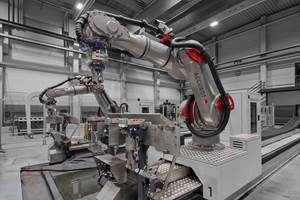BBG supplies electric composite press for aircraft interior parts production
Ordered by a reputed U.S. aerospace company, the press gives the advantage of high efficiency, quiet operation, easier maintenance and overall shorter cycle times.
The electric press opens wide enough for operators to access the mold comfortably. Photo Credit: BBG Gmbh & Co. KG
In December 2022, industrial equipment supplier (Mindelheim, Germany), supplied an electric composite press for the manufacture of aircraft interior parts to a reputed aerospace company in the U.S. The cooperation between the two companies goes back to a project managed by U.S. subsidiary BBG North America. Composite prototype parts were produced for the aircraft manufacturer at the BBG technical center at Oxford, Mich, U.S., and, satisfied with the production technology, the aerospace company ordered a pilot plant, including the molds, for the production of lightweight components.
BBG relies on decades of experience in the development and manufacture of mold carrier systems and composite presses. While hydraulic presses continue to be a standard in the field of composites, the U.S. customer is said to have intentionally chosen a system that is equipped with an electric drive. One of their main advantages, BBG notes, are the systems’ high level of efficiency, which reduces energy consumption by around 35 watt-hours per production cycle. Further benefits include particularly quiet operation and high dynamics, which contribute to shorter cycle times. Moreover, an electric drive is easier to maintain than the hydraulic variant.
All electric press systems are manufactured in and shipped from Mindelheim, Germany. The composite press mentioned above is specifically configured for use in aircraft construction. The mold is manufactured by BBG North America and then shipped at the same time as the press.
The mold mounting plates are 2,200 × 1,500 millimeters. Molds can be moved and positioned with little effort, thanks to integrated pneumatic roller bars. The angle of traverse of the lower carrier plate is zero to 27º, and that of the upper plate is zero to 75º. According to BBG, this opens the press wide enough for operators to access the mold comfortably. Maximum capacity is 3,500 kilograms for the lower plate, and 3,000 kilograms for the upper plate.
Intelligent pressure control enable a press force of 60 U.S. tons — which corresponds to about 535 kilonewtons — and an infinitely variable adjustment option from 50 kilonewtons onward.
In addition, the composite press is operated via the Easy Control 2.0 user interface developed by BBG. The man-machine interface reportedly simplifies the programming and operation of the press while increasing productivity and improving process reliability. For most of BBG’s customers, this is a core concern, just as in aircraft manufacturing, production must deliver reliable results while being simple and manageable. The user interface shows the press and mold functions and workflows so that users are able to operate the machine quickly and easily without PLC knowledge.
BBG GmbH & Co. KG is an international system partner for the plastics processing industry with its own mold, machine and plant construction. In addition to end-to-end production lines, BBG designs, develops and manufactures molds for processing polyurethane (PUR), PVC, TPE and other elastomers, as well as a wide range of composite materials. This includes production processes such as PUR composite spray molding (PUR-CSM), long fiber injection (LFI), resin transfer molding (RTM), sheet molding compound (SMC) or glass mat-reinforced thermoplastics (GMT). The company also focuses on solutions for lightweight construction, the processing of composites and the production of fiber-reinforced composite components in a large number of industries in Asian, European and North American markets. Since 2020, the company has also developed and built packaging machines for pharmaceutical products and food supplements.
Related Content
Plant tour: Collins Aerospace, Riverside, Calif., U.S. and Almere, Netherlands
Composite Tier 1’s long history, acquisition of stamped parts pioneer Dutch Thermoplastic Components, advances roadmap for growth in thermoplastic composite parts.
Read MoreInfinite Composites: Type V tanks for space, hydrogen, automotive and more
After a decade of proving its linerless, weight-saving composite tanks with NASA and more than 30 aerospace companies, this CryoSphere pioneer is scaling for growth in commercial space and sustainable transportation on Earth.
Read MorePlant tour: Airbus, Illescas, Spain
Airbus’ Illescas facility, featuring highly automated composites processes for the A350 lower wing cover and one-piece Section 19 fuselage barrels, works toward production ramp-ups and next-generation aircraft.
Read MoreAutomated robotic NDT enhances capabilities for composites
Kineco Kaman Composites India uses a bespoke Fill Accubot ultrasonic testing system to boost inspection efficiency and productivity.
Read MoreRead Next
BBG GmbH becomes international system partner for automated production and materials processing
Full-range supplier manufactures supplies for fully automated production modules, molds for composite processes and produces composite components for lightweight construction.
Read MoreUltrasonic welding for in-space manufacturing of CFRTP
Agile Ultrasonics and NASA trial robotic-compatible carbon fiber-reinforced thermoplastic ultrasonic welding technology for space structures.
Read MoreCeramic matrix composites: Faster, cheaper, higher temperature
New players proliferate, increasing CMC materials and manufacturing capacity, novel processes and automation to meet demand for higher part volumes and performance.
Read More












